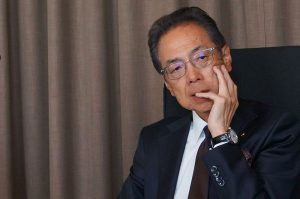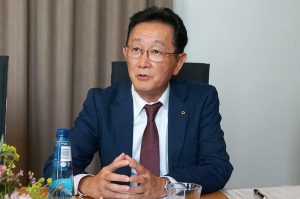
- News
- Basics
- Products
- JP Job shop
- Exhibition
- Interview
- Statistic
- PR
- Download
- Special contents
Interview
August 21, 2024

In Part 1, SEISANZAI Japan reported on how AMADA expanded its automation equipment manufacturing base in Finland to meet the high demand for automation in the European market. In this Part 2, our team interviewed Tsutomu Isobe, Chairman of AMADA, and Takaaki Yamanashi, President of AMADA, to discuss the company’s global strategy.

Representative Director, Chairman of AMADA, Tsutomu Isobe
Chairman Isobe:
There are two key points in our “Medium-term Business Plan 2025,” which we announced last year. The first is our growth strategy, looking toward 2030. We aim to increase sales of our core “Laser and Welding Business” to 200 billion yen, or 1.8 times the fiscal 2022 level. We are also expanding into new businesses fields such as e-mobility, medical, and semiconductor. The second key point is our global market expansion strategy. We divide the world into four regions: Japan, North America, Europe, and Asia, and we are striving to enhance our supply system through global manufacturing reforms and improve profitability. Of course, we aim to increase sales in each market, especially in Asia, where we plan to increase sales from 51.2 billion yen in 2022 to 90 billion yen in 2030, an increase of 76%.
Chairman Isobe:
The European market is characterized by high demands for automation and labor savings. That is why we expanded and renewed our automation equipment plant in Finland, an environmentally advanced country (see Part 1). With our high-productivity fiber laser processing machines and sheet metal bending machines, we already have a solid foundation for expanding our market share. In addition, the growth driver for the European market is environmental investment, which makes it a challenge to strengthen the production capacity of our European base that handles automation and systematization.

Representative Director, President of AMADA, Takaaki Yamanashi
President Yamanashi:
In Europe, 60% of laser processing machines are already sold with automation systems, and this ratio is increasing every year. For thin sheets up to 4-5mm thick, higher power translates into higher cutting speeds, increasing productivity by 1.5 to 2 times. This requires automation of pre- and post-processing, such as material and part handling. As well as the evolution of processing machines, there has also been a gradual change in our customer base. With high-power machines capable of processing medium-thickness plates, laser processing machines are increasingly being used for large parts that were traditionally processed by fusion cutting, such as those for civil engineering and construction machinery. There is also a growing demand for bending thick steel plates, such as 9mm and 12mm, with sheet metal bending machines. Obviously, both materials and parts are very heavy, so manual transport is almost impossible and requires automation.
President Yamanashi:
At the “AMADA Global Innovation Center (AGIC)”, which opened last year at our headquarters in Isehara, Kanagawa Prefecture, Japan, we are engaged in consulting on cutting-edge machining technology, covering everything from micro-machining to large workpieces the size of buildings. The results obtained here are transferred to Solution Centers in each country in the form of mini-AGICs. The theme of the AGIC is “From What We Can Do to Why We Can Do It”. By explaining why it is possible, we can clearly communicate the unique selling points of our machines.
President Yamanashi:
We start procuring parts made in India from fiscal 2024, and will eventually aim to procure parts modules and consider OEM outsourcing. Many machine parts do not necessarily require high precision. Sourcing them in large quantities from India, for example, can be 30-40% cheaper than domestic procurement. Many Japanese automakers and parts manufacturers have already entered the Indian market, and there are many local manufacturers to ensure quality.
Chairman Isobe:
Selling, general and administrative expenses and labor costs are not easy to reduce. While procurement costs are rising, we cannot pass on all costs to prices. Therefore, we need to consider how to reduce procurement costs. After a special team investigated the Indian market, we found that good products could be obtained at lower costs than we’d expected. After careful consideration, we concluded that it is a market where we can continue to do business due to stable labor costs, minimal geopolitical supply risks and relatively stable exchange rates. Given the future growth potential, India is a country we want to partner with, even for OEM production in the future.
Chairman Isobe:
Even if our existing businesses grow at a steady pace, it is difficult to expect a sudden increase once we exceed 400 billion yen. It will be necessary to secure revenue from new businesses. Although we have achieved 415 billion yen in fiscal 2023, the yen could strengthen in the future. Under this premise, we are aiming for a total of 500 billion yen by exploring new areas and considering M&A (mergers and acquisitions).
-End
By: Shu Yasumi
Editor-in-Chief, SEISANZAI Japan
October 15, 2025